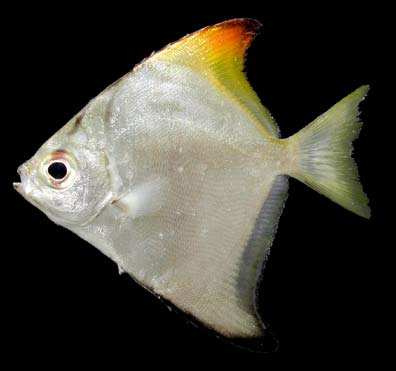| MONODACTYLIDAE |

Monodactylus argenteus, 6.2 cm SL
(photo by Koichi Shibukawa)
|
Monodactylus argenteus (Linnaeus, 1758) Silver Moony |
|
D VII-VIII, 26-31; A III, 26-31. Body oval, deep and strongly compressed. Eye moderately large, its diameter longer than snout length. Mouth small and oblique. Anterior soft fin rays of both dorsal and anal fins elongated, situated at midlength of body; posterior edge of dorsal and anal fins distinctly concave; caudal fin slightly emarginate; pelvic fins rudimentary or absent in adults. Body, head, and unpaired fins covered by small, deciduous scales. Color: adults bright silver, tip of dorsal and anal fins dusky; juveniles more colorful with yellow over most of the dorsal fin; tip of dorsal and anal fins black; anterior edge of anal fin with broad black margin; two vertical black bars over the head, one through the eye and the other in front of pectoral-fin base. Size: maximum length about 25 cm. Distribution: Indo-West Pacific: Red Sea and South Africa to Samoa, north to the Yaeyamas (Japan), south to New Caledonia and Australia. Remarks: Commonly found in mangrove estuaries, sometimes found in silty coastal reefs, and can live in freshwater. Small juveniles solitary or in small aggregations. Feeds on plankton and detritus. Highly territorial. |
|
|